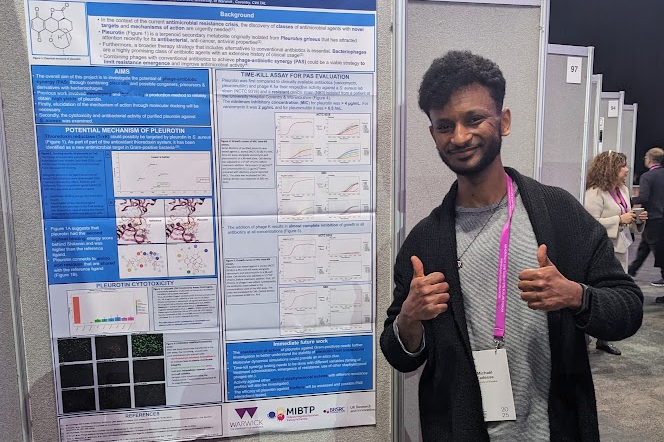Mushroom chemical teams with phages to deliver a one-two punch to MRSA

A chemical found in mushrooms can be teamed with bacteriophages to deliver a one-two punch to antibiotic-resistant infections, reveals a study presented at MLS Future Forum 2025.
The research was one of the winning presentations at the Minoritised Life Scientists Future Forum at the ICC in Birmingham in April 2025, netting a prize of a LUMI module from Reach Industries for its corresponding author Michaël D Tadesse, a PhD graduate of the School of Life Sciences, University of Warwick.
In his presentation, Michaël revealed that the natural product pleurotin exhibits potent antibacterial activity against Staphylococcus aureus when combined with bacteriophages, demonstrating phage-antibiotic synergy (PAS), which could help combat antibiotic-resistant infections using a one-two punch approach.
“Antibiotic resistance is an escalating global health crisis, especially involving pathogens like Staphylococcus aureus (i.e. MRSA, VISA and VRSA strains). Existing antibiotics are increasingly ineffective, and the pipeline for new drugs is limited due to the high cost and complexity of traditional drug discovery,” he explained.
“This study sought to explore new antibacterial strategies by evaluating the combination of pleurotin, a natural compound, originally isolated from Hohenbuhelia grisea mushrooms that grow on rotting wood.
“It previously demonstrated antibacterial, antiviral and anticancer activity, but also showed cytotoxicity. The aim was to uncover novel treatment avenues by combining it with bacteriophages for resistant staphylococcal infections.”
The research team began by producing pleurotin via fermentation of Hohenbuhelia grisea in shake flasks and bioreactors, achieving sufficient yields for biological testing. Its potential mechanism of action was examined using molecular docking and molecular dynamics simulations, which suggested pleurotin targets bacterial thioredoxin reductase, a promising but underexplored antimicrobial target.
They then evaluated pleurotin’s antibacterial activity and cytotoxicity in vitro and compared it to established antibiotics like vancomycin and pleuromutilin. Pleurotin showed potent activity against S. aureus and an acceptable cytotoxic profile.
The final step was to explore its use in phage-antibiotic combination (PAC) therapy. Pleurotin, vancomycin and pleuromutilin all showed synergy with phage K under experimental conditions.
One unexpected observation was the synergistic effect of pleuromutilin, a protein synthesis inhibitor, with phage K.
“Prior literature suggested that protein synthesis inhibitors can often yield antagonistic results when combined with phages. This result suggests that synergy can still occur depending on phage concentration and bacterial susceptibility, and it challenges early assumptions about class-based PAC compatibility,” Michaël said.
“This work supports the idea that natural products like pleurotin, when combined with phages, can serve as powerful new tools in the fight against antibiotic-resistant bacteria.
“The potential to dilute pleurotin’s concentration while maintaining efficacy through synergy with phages is especially significant, as it could help mitigate side effects from potential cytotoxicity. The findings also expand the known compatibility landscape for phage-antibiotic combinations, offering new directions for therapy design.
“Future work should involve testing pleurotin-phage combinations against MRSA and vancomycin-resistant S. aureus strains. Additionally, longer molecular dynamics simulations and refined free energy analyses are needed to confirm pleurotin’s mechanism.
“In vitro PAC experiments should also explore optimal phage/antibiotic ratios, timing, and use of other phages or phage cocktails. Further, overcoming biofilm resistance remains a key challenge for follow-up research.”
The study was mostly undertaken by Dr Michaël Tadesse as part of his PhD project at the University of Warwick under the supervision of Dr Antonia Sagona and Dr Fabrizio Alberti. The study was supported by the contributions from Nala Ali, Martha White and Dr Lijiang Song. If you would like to read more, most of the work (excluding the molecular docking/dynamics) was recently published in ACS Omega: https://doi.org/10.1021/acsomega.4c09831



